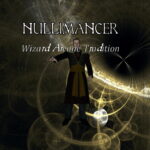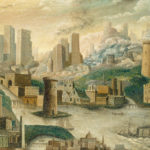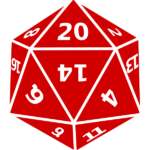The Honest truth about Dungeons and Dragons
Much ink and way too much sweat has been shed over the question of negative influences of fantasy role-playing games (FRPGs) like Dungeons and Dragons (D&D) and Advanced Dungeons & Dragons (AD&D). Much of this is due to miscommunication, distributed half-truths, and exceptions perceived as rules.
I would like to clear the air on some of these misunderstandings.
Since it’s impossible to separate a text from its author, some qualifications may be in order. I’ve been playing FRPGs since 1983 when I played with some fellow Boy Scouts. When confronted with the allegedly negative aspects, as a Christian, I was concerned, so I read everything I could get my hands on regarding the subject, both pro and con. I have a B.A. in Psychology and Theatre and a M.Div. I’m an ordained Pastor (LCMS).
Aren’t FRPGs Pagan?
Not necessarily. It depends on who’s playing the game. D&D and AD&D were designed around medieval miniature strategy war-games, Greco-Roman mythology, medieval legends (like King Arthur), and the writings of J.R.R. Tolkien (an outspoken Christian writer). The idea was to get a group of people together to write a story in their minds. The group is led by a Dungeon Master (DM) who serves as narrator, setting the scene, supplying the plot, and portraying the supporting cast. The main characters are portrayed by the players, like a puppet show with no script. As the DM presents the story, each player informs the DM of his character’s actions.
Polytheism
Now, because of the historical background of the setting, you will find an element of polytheism in the game. However, even those playing clerics (priests) of these gods are not actually worshipping these gods. His character does, but not with any detail. Generally, the sum of the “worship” goes something like, “My character goes off and prays for three hours,” and that’s about it. The gods are not thought to be real any more than the character who worships it.
Sorcery
Also, some have expressed concern over sorcery present in the game. Players have the option of choosing characters who are wizards like Merlin or Gandalf. Please note that, when a wizard character casts a spell, the player utters no incantation. Characters cast spells; players do not. When a player wants his character to cast a spell, he merely states, “My character is going to cast a (fireball, light, etc.) spell.” No actual ritual is described nor performed.
Yeah, but what about the immorality associated with FRPGs?
The three big concerns in this area about FRPGs are suicide, violence, and immersion.
Suicide
First, several suicides have been attributed to FRPGs. It usually goes along the line of, “My son’s character was killed, so he killed himself.”
First of all, the suicide rate among gamers is significantly lower among gamers (in the USA; I haven’t checked elsewhere) than the national average. Nearly every gamer who commits suicide makes the news, and the game is blamed, yet these stories are rare compared with the frequency of teen suicide in our nation. FRPGs become a scapegoat because no one wants to admit that their dead child was psychologically unbalanced. When children are playing FRPG’s like “Cowboys and Indians,” a much more violent, more involved game (they actually act it out), they don’t commit suicide when their friends shoot them with plastic guns. I won’t go so far as to say that FRPGs prevent suicide, because creative people (like those who play FRPGs) are less prone toward suicide. (Creativity, p. 247)
Violence
FRPGs often have a lot of violence described within the game. This argument is valid, yet it raises the question of perceived violence. While violence is the result of sin, it is not itself sinful. The Bible is one of the most violent collections ever assembled, yet the violence in the Bible has a point, as does the violence in FRPGs. (eg. A party of adventurers goes to kill a dragon to protect a city.) The violence in FRPGs is neither worse than nor more real than that in movies like Star Wars. Note the irony that some people who are against FRPGs have no problems with hunting or watching the evening news.
Immersion
Finally, immersion is a catchall category relating to people who become addicted to or consumed with the game. From my perspective, which in this case is the Lord’s perspective, our priorities must be God first, family second, and everything else after that. As with any enjoyable activity, people can become addicted to gaming. The same can be true of web surfing, fishing, eating, or sex, none of which are inherently evil or addictive. Of the documented cases of those who lose their identities and can’t separate reality from the game, the loose contact with reality was generally present apart from the game. These same people should stay away from books, movies, and plays, too.
Advantages
Now, all that aside, I have observed several advantages of FRPGs.
Creativity
First, the sheer volume of imagination exercised by those playing these games is unsurpassed among popular pastimes, and the more one excercises his creativity, the more he’ll have, much like a muscle.
Teamwork
FRPGs also encourage teamwork. Few characters could slay a dragon by themselves. They work together, carefully planning their strategies based on each one’s abilities. In the church, we call this the Body of Christ. In business, the same concept applies. FRPGs exercise this kind of thinking.
Academics
History
FRPGs also aid in several areas of academics. I never had a course in world history in high school (long story involving transfers), yet I know more about it than most of my peers in college because of my interest in history for the sake of helping me play FRPGs.
Literature
Also, I’m a slow reader, thus I don’t usually read much, but my interest in FRPGs incited me to read a great deal of literature, including the Iliad & Odyssey, a ton of mythology, related encyclopedia articles and other documents, Tolkien, C.S. Lewis, Lloyd Alexander, and innumerable other works, not to mention all the history and political science resources.
Writing
Creative writing and grammar are important to those writing articles and modules (story outlines) for distribution. FRPGs have already been cited as being a source of creativity.
Math
Depending on the game, some require a great deal of math work. This can run from adding the results of a handful of dice to complicated character creation processes (cf. Harn) to abstract three-dimensional mapping in many science fiction games (cf. Space Opera).
Art
While fantasy artwork is sometimes risqué, this is true of nearly all genres of art. That aside, many FRPG players, myself included, are motivated to learn art techniques for the game, whether to draw their characters or to draw the castles, monsters, heraldry, etc. In any gaming group, you’ll nearly always find at least one artist.
Language
Show me a gamer with a limited vocabulary, and I’ll show you someone who hasn’t played for long. When I started playing, I constantly found myself in a dictionary, looking up words like, “charisma,” “halberd,” and “somatic.”
Morality
Finally, the question of morality and the values conveyed by the game needs addressing. FRPGs, including AD&D, are neutral. Being commercial games, they encourage neither good nor evil. That said, the rules are centered around the assumption that the characters will be non-evil. The movement of the game is directed greatly by the DM, but players are free to make their own choices. Also, studies have shown that it is generally easier to advance a person’s moral judgment to a higher stage than to a lowered one through role-playing. Of note are:
Rest, J.R. (1979) Development in judging moral issues. Minneapolis: University of Minnesota Press.
Ibid. (1983) “Morality.” In J. Flavell & E. Markman (eds.) Handbook of Child Psychology: vol. 3. Cognitive Development. NY: Wiley.
Turiel, E. (1966) “An experimental test of the sequentiality of development stages in the child’s moral judgments.” Journal of Personality and Social Psychology, 3, 611-618.
According to these studies, FRPGs can actually be used to raise, but not lower, the participants’ morality.
Conclusion
Are you still concerned or have questions? My best advice is to observe, or even better, play in a game or two, just to get a feel for how it’s done. Most universities have gaming groups who would be happy to help you. Discuss your concerns with the players, and be specific. Beyond that, you can contact me.
Return to  home. ]]>
home. ]]>



